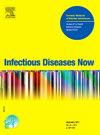What’s new in the diagnosis and treatment of human brucellosis?
IF 2.2
4区 医学
Q2 INFECTIOUS DISEASES
引用次数: 0
Abstract
Brucellosis is a reemerging zoonotic infectious disease caused by Brucella spp. and posing significant global health challenges. Focusing on epidemiology, pathophysiology, diagnostic tools, and therapeutic management, the present review synthesizes recent advances in the diagnosis and treatment of brucellosis. Notwithstanding global control efforts, brucellosis remains endemic in various regions, with emerging species and hosts complicating its epidemiology. The mechanisms of Brucella intracellular survival, including evasion of host immune responses and manipulation of cellular processes, contribute to its persistence and pathogenicity. Diagnostic challenges are addressed through culture-based methods, serological tests, and molecular assays, with recent innovations showing enhanced sensitivity and specificity. Treatment involves prolonged antibiotic therapy, consisting in combination regimens tailored to disease severity and patient-specific factors. However, the emergence of antibiotic-resistant strains necessitates continuous surveillance and application of alternative therapeutic strategies. Prevention programs emphasize surveillance and vaccination of livestock, biosecurity measures, and public education designed to reduce transmission. Laboratory safety protocols are crucial to prevent contamination during the handling of suspected brucellosis samples. Future research should focus on proteomic and transcriptomic analyses in view of identifying resistance mechanisms and improving management strategies. This comprehensive review highlights the need for coordinated efforts to control brucellosis and mitigate its impact on public health.
人类布鲁氏菌病的诊断和治疗有什么新进展?
布鲁氏菌病是由布鲁氏菌引起的一种重新出现的人畜共患传染病,对全球卫生构成重大挑战。本文从流行病学、病理生理学、诊断工具和治疗管理等方面综述了布鲁氏菌病的诊断和治疗方面的最新进展。尽管做出了全球控制努力,但布鲁氏菌病仍在各区域流行,新出现的物种和宿主使其流行病学复杂化。布鲁氏菌的细胞内存活机制,包括逃避宿主免疫反应和操纵细胞过程,有助于其持久性和致病性。诊断挑战是通过基于培养的方法、血清学测试和分子分析来解决的,最近的创新显示出更高的灵敏度和特异性。治疗包括长期抗生素治疗,包括根据疾病严重程度和患者特定因素量身定制的联合方案。然而,抗生素耐药菌株的出现需要持续监测和应用替代治疗策略。预防项目强调对牲畜的监测和疫苗接种、生物安全措施以及旨在减少传播的公共教育。实验室安全规程对于在处理疑似布鲁氏菌病样本期间防止污染至关重要。未来的研究应集中在蛋白质组学和转录组学分析,以确定耐药机制和改进管理策略。这一全面审查强调需要协调努力控制布鲁氏菌病并减轻其对公共卫生的影响。
本文章由计算机程序翻译,如有差异,请以英文原文为准。
求助全文
约1分钟内获得全文
求助全文
来源期刊

Infectious diseases now
Medicine-Infectious Diseases
CiteScore
7.10
自引率
2.90%
发文量
116
审稿时长
40 days
 求助内容:
求助内容: 应助结果提醒方式:
应助结果提醒方式:


